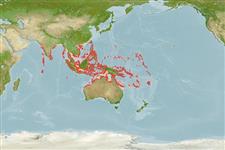Common names from other countries
Classification / Names / Names
Nomi Comuni | Sinonimi | Catalog of Fishes (gen., sp.) | ITIS | CoL | WoRMS
Environment: milieu / climate zone / depth range / distribution range
Ecologia
Associati a barriera corallina; distribuzione batimetrica 0 - 30 m (Ref. 848). Tropical; 24°N - 26°S, 70°E - 180°E (Ref. 848)
Indo-West Pacific: Maldives to Melanesia, north to Taiwan and south to Australia.
Length at first maturity / Size / Peso / Age
Maturity: Lm ? range ? - ? cm
Formation: small, flat, or dome-shaped. Corallites: phaceloid, often monocentric but may have up to 3 centers; average of 16 mm in diameter. Septal teeth: few, long and conspicuous. Columellae: circular to oval; well developed. Color: mottled orange, green or white; mouths often pale (Ref. 848).
Occurs in upper reef slopes and lagoons (Ref. 848).
Life cycle and mating behavior
Maturità | Riproduzione | Deposizione | Uova | Fecundity | Larve
Members of the class Anthozoa are either gonochoric or hermaphroditic. Mature gametes are shed into the coelenteron and spawned through the mouth. Life cycle: The zygote develops into a planktonic planula larva. Metamorphosis begins with early morphogenesis of tentacles, septa and pharynx before larval settlement on the aboral end.
Veron, J.E.N. 2000. (Ref. 848)
IUCN Red List Status (Ref. 130435)
CITES status (Ref. 108899)
Not Evaluated
Human uses
| FishSource |
Strumenti
Informazioni ulteriori
Age/SizeAccrescimentoLength-weightLength-lengthMorfologiaLarveAbbondanza
Fonti Internet
Estimates based on models
Preferred temperature
(Ref.
115969): 26.6 - 29.3, mean 28.7 (based on 2671 cells).
Price category
Unknown.
